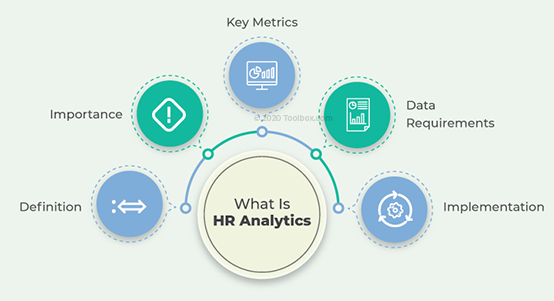Often used interchangeably, HR analytics and People analytics revolve around the data-driven analysis of the employees of a company. This analysis helps study the trends and display insights that imply the improvements in the organization.
But the HR analytics trends and people analytics trends are available in different types. Additionally, as the world moves on from a pandemic and finds newer approaches to make their business experience and initiatives more successful, fresh trends are introduced to be implemented in the year 2022.
This blog will talk about the different HR analytics and people analytics trends applicable from the year 2022. Furthermore, we shall also discuss the difference between HR analytics and People analytics. Additionally, we’ll shed some light on the importance of HR software to implement those trends. Read on.
What is People Analytics?

People analytics deals with the data-driven and goal-focused methods related to people processes, opportunities at work, functions, and challenges. These are essential elements required to achieve sustainable business success and elevate the various components.
People analytics is similar to and often interchangeably used as talent analytics or HR analytics as well. It is a crucial assessment approach for better decision-making. It involves the application of statistics and data interpretation techniques.
Such strategic and smart data-backed decisions are more accessible and applicable for an employee’s entire period. Whether to make better hiring decisions or effective performance management allows you to gain better retention.
Are People Analytics and HR Analytics the Same?
It is essential to clear the doubts between the terminologies—HR analytics and people analytics. Like previously mentioned, HR analytics and people analytics are often interchangeably used. However, they are not the same.
HR analytics revolves around the management and functioning initiatives of the HR team. For instance, the HR analysis would cover the Key Performance Indicators like hiring time, employee turnover, etc. These analytics are limited and relevant to the HR team responsible for these processes.
On the contrary, people analytics has a limitless scope. It encompasses the processes of the HR team, customer insights, and the entire workforce team. It represents the measures and analysis of such information and knits it together to provide better decision-making processes and enhanced business performance.
HR and People Analytics Trends to Expect in 2022
Large established companies like Alphabet, Apple, and Microsoft are implementing new and unique approaches, HR analytics trends, and People analytics trends to improve the organizational processes and move towards a smooth transition to digital transformation.
Here are the HR and people analytics trends applicable from 2022 in the bigger and developing companies.
01. Better Emphasis on Employee Well-being

Employee wellbeing is one of the priorities of the HR and People analytics trends for the coming year, 2022. Both HR and People analytics are combined in this pursuit. The pandemic made it clear that employee wellbeing is crucial for every business.
It is much better to prevent the poor wellbeing conditions of the employee and employee absence rather than dealing with the potentially intense consequences. But it is not limited to physical health. Employee wellbeing considers all the aspects of an employee that makes them happy and healthy.
02. Organizational Network Analysis
Not all companies have already taken up the organizational network analysis approach. Although it has been in the plan for quite a while, it is yet to become mainstream. That is because businesses and companies lack user-friendly applications, poor communication, lack of knowledge among the leaders, and more such reasons.
That is why it has been put forward that ONA and software-based solutions are to be taken up prominently from the next year as part of people analytics trends.
03. Rising Internal Mobility and a Shift in the Hiring Process

Internal mobility and the team’s growth through productivity and budgetary benefits are likely to get cranked up a notch. Most of the learning and development approaches revealed that a greater priority is to elevate the internal hires to make a greater share of all the hires.
It has shown significant improvement in the last couple of years, and it is likely to move towards better retention, increasing hire productivity, and acceleration of the hiring process.
04. Bridge the Skill Gap with Value-Driven Metrics

The skill gap refers to the gap between the skill required to be eligible for a job and the ones possessed by the employee. But such gaps have taken the form of a canyon. That is because of the changes rooting out of the pandemic.
The public health guidelines about operating with distance maintenance have led to the companies finding new ways of operation. While some have resorted to remote work, others have limited the on-site employees. Most companies have also introduced new business models to respond to the changing consumer behavior.
Additionally, companies have taken measures to transform to a completely digital platform, shaking hands with the emerging technologies.
05. People Analytics

Businesses need access to the appropriate framework, model, or expertise that ensures the meaning of the data received. So, when the time arrives, it can be either guesswork or data-driven decisions.
The HR department uses such data for people analytics to generate better business results and management of the team at work. The introduction of SaaS and cost-effective HR software and technological tools have made the tasks of the HR department much easier.
With such tools and software, they can quickly dive into HR metrics such as performance turnover, diversity hires, revenue per employee, etc.
Summing Up
These are the five trends of 2022, among many others, to be taken up in the coming year. The human resources department is growing with more responsibilities and better approaches to ease their functions.
This is a time for the HR department to meet with new challenges. However, 2022 is all set to welcome the bright side of the pandemic.
The pandemic led to the discovery of such trends that are to be implemented in the new year. These trends are supposed to ease the functions of the company and workforce.













